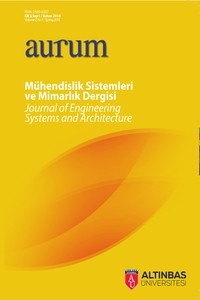A MODIFIED SALP SWARM OPTIMIZATION ALGORITHM BASED ON THE LOAD FREQUENCY CONTROL OF MULTIPLE-SOURCE POWER SYSTEM
A MODIFIED SALP SWARM OPTIMIZATION ALGORITHM BASED ON THE LOAD FREQUENCY CONTROL OF MULTIPLE-SOURCE POWER SYSTEM
salp swarm algorithm (SSA), Load Frequency Control (LFC) Multi Source Power System, Integral Absolute Error (IAE).,
___
- Kundur P. Power system stability and control. New York: Mc-Graw Hill; 1994.
- Elgerd OI. Electric energy systems theory an introduction. New Delhi: Tata McGraw-Hill; 1983.
- Hassan B. Robust power system frequency control. New York: Springer; 2009.
- Mohanty, B., Panda, S., & Hota, P. K. (2014). Controller parameters tuning of differential evolution algorithm and its application to load frequency control of multi-source power system. International journal of electrical power & energy systems, 54, 77-85.
- Mirjalili, S., Gandomi, A. H., Mirjalili, S. Z., Saremi, S., Faris, H., & Mirjalili, S. M. (2017). Salp Swarm Algorithm: A bio-inspired optimizer for engineering design problems. Advances in engineering software, 114, 163-191. McCauley, D. J., Pinsky, M. L., Palumbi, S. R., Estes, J. A., Joyce, F. H., & Warner, R. R. (2015). Marine defaunation: Animal loss in the global ocean. Science, 347(6219), 1255641
- Abualigah L., Shehab M., Mohammad Al Shinwan, H. M. A. (2019). „salp swarm algorithm comprehensive survey. Neural Computing and Applications. 8 - M. L., Aspects of jet propulsion in salps.,‖ Can J Zool 68765–77., 1990
- Shehab, M., Khader, A. T., & Al-Betar, M. (2016). New selection schemes for particle swarm optimization. IEEJ Transactions on Electronics, Information and Systems, 136(12), 1706-1711
- Rizk-Allah, R. M., Hassanien, A. E., Elhoseny, M., & Gunasekaran, M. (2019). A new binary salp swarm algorithm: development and application for optimization tasks. Neural Computing and Applications, 31, 1641-1663
- Abusnaina M., Ahmed A. Ahmad, Sobhi Jarrar, Radi Mafarja, “Training neural networksusing Salp Swarm Algorithm for pattern classification, ACM,‖ Int. Conf. Proceeding Ser.,2018.
- Abbassi, R., Abbassi, A., Heidari, A. A., & Mirjalili, S. (2019). An efficient salp swarm-inspired algorithm for parameters identification of photovoltaic cell models. Energy conversion and management, 179, 362-372.
- Anderson, P. A. V., & Bone, Q. (1980). Communication between individuals in salp chains. II. Physiology. Proceedings of the Royal Society of London. Series B. Biological Sciences, 210(1181), 559-574.
- Andersen, V., & Nival, P. (1986). A model of the population dynamics of salps in coastal waters of the Ligurian Sea. Journal of plankton research, 8(6), 1091-1110.
- Henschke, N., Smith, J. A., Everett, J. D., & Suthers, I. M. (2015). Population drivers of a Thalia democratica swarm: insights from population modelling. Journal of Plankton Research, 37(5), 1074-1087.
- Mirjalili, H. F. (2019) Salp Swarm Algorithm: Theory, Literature Review, and Application inExtreme Learning Machines ,‖ Nature-Inspired Optim. pp 185-199.
- Shehab, M., Khader, A. T., & Laouchedi, M. (2018). Modified cuckoo search algorithm for solving global optimization problems. In Recent Trends in Information and Communication Technology: Proceedings of the 2nd International Conference of Reliable Information and Communication Technology (IRICT 2017) (pp. 561-570). Springer International Publishing.
- Ibrahim, R. A., Ewees, A. A., Oliva, D., Abd Elaziz, M., & Lu, S. (2019). Improved salp swarm algorithm based on particle swarm optimization for feature selection. Journal of Ambient Intelligence and Humanized Computing, 10, 3155-3169.
- Abusnaina, A. A., Ahmad, S., Jarrar, R., & Mafarja, M. (2018, June). Training neural networks using salp swarm algorithm for pattern classification. In Proceedings of the 2nd international conference on future networks and distributed systems (pp. 1-6).
- Achelia, D. (2018, November). A chaotic binary salp swarm algorithm for solving the graph coloring problem. In Modelling and Implementation of Complex Systems: Proceedings of the 5th International Symposium, MISC 2018, December 16-18, 2018, Laghouat, Algeria (Vol. 64, p. 106). Springer
- Abbassi, R., Abbassi, A., Heidari, A. A., & Mirjalili, S. (2019). An efficient salp swarm-inspired algorithm for parameters identification of photovoltaic cell models. Energy conversion and management, 179, 362-372.
- ISSN: 2564-6397
- Yayın Aralığı: Yılda 2 Sayı
- Başlangıç: 2017
- Yayıncı: Altınbaş Üniversitesi
A MISSING DATA IMPUTATION METHOD BASED ON GREY WOLF ALGORITHM FOR DIABETES DISEASE
USING FEATURE SELECTION AND ACO ALGORITHM FOR OPTIMIZING SMART CLASSROOM
Dhuha Abdulameer Abd Ali Abd Ali ABD ALI, Hasan Hüseyin BALIK
COMPARISON OF SKYSCRAPER BUILDING DESIGN: ISOLATED FOUNDATIONS VS. NON-ISOLATED FOUNDATIONS
XGBOOST ALGORITHM FOR ORECASTING ELECTRICITY CONSUMPTION OF GERMANY
Abdullahı Abdu IBRAHIM, Khalıd Mohamed Abdullah ELZARIDI
Anas Mahdi AL-ZUBAIDI, Galip CANSEVER
AN INTEGRATED METHOD FOR REFOCUSING OF MOVING TARGETS IN SPOTLIGHT SAR
İbrahim PAPİLA, Selçuk PAKER, Mesut KARTAL
CREATING ARCHITECTURAL PROGRAMMING FOR A STUDENT UNION PROJECT
Büşra Nur AYDIN AKTAŞ, Afra Nur BOZKURT, Tomas MALEZ
Amany Lotfy A. S. SAWABY, Göksel DEMİR
